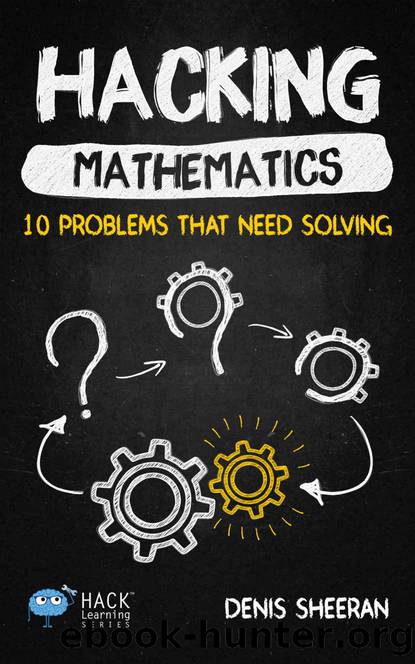Hacking Mathematics: 10 Problems That Need Solving (Hack Learning Series Book 17) by Sheeran Denis

Author:Sheeran, Denis [Sheeran, Denis]
Language: eng
Format: epub
Publisher: Times 10 Publications
Published: 2018-03-17T16:00:00+00:00
A blueprint for full implementation
Step 1: Sell it to your students.
Any time a new product comes around, its longevity is made or broken by the sales pitch. I saw an ad for a kidsâ science kit that gets delivered to your house once a month and has what looked like unique and cool experiments for you and your kids to do together. But then it happened. In the ad, one of the parents walked around the corner with the new science box, smiled expectantly, and kneeled as the kids rushed up for a big hug, because, you know, YAY, their new science kit was here . . . Sorry, as a father of four, the ad didnât resonate with me because I know that the real scene would either be much more like hyenas tearing up a freshly fallen giraffe, or a wave of teenage indifference. The sales pitch of hugs, smiles, and family chemistry time turned me off as too fake, despite my initial interest in the product.
Develop a sales pitch that will make your students want to buy into the âproductâ of relevant math. This is usually done by good storytelling. You donât have to be Shakespeare; youâve just got to know how to tell a story without making it all mathy right away. If youâve got an idea from a photo or video or experience that you want to turn into a great math question, plan the story so that the kids are the ones who get around to asking the question. Bait the hook, donât toss dynamite into the pond. Theyâll take the bait.
Step 2: Start as small as you need to and gradually increase.
Maybe youâre the type of teacher whoâs married to the pacing guide, till death or a new textbook do you part. You may feel the struggle of wondering where youâre supposed to fit these types of questions and activities into your already packed schedule. Take out a useless part; thatâs where you find the time. Andrew Stadel ( @MrStadel ) has a great talk on the classroom clock and how we spend too much of our time on things that should take up almost no time at all. Evaluate your classroom clock and see what you can sacrifice to make space for more relevant topics. Then try it.
If youâre recently or long-since divorced from your pacing guide, and time isnât a problem, then you may be ready for more right away. Start with stories from your experiences that lead to good math questions. Become great at listening to your students speak so you know when to prospect the gold mines of their perspectives and interests. I firmly believe that you could remake a full math course curriculum with questions you discover day by day.
Step 3: Document what youâve done and save the good ones.
If youâve found an excellent experience, photo, video, location, or mystery that you realize has led to an excellent math experience in your class, document it and include it in your classes for as long as it is relevant.
Download
This site does not store any files on its server. We only index and link to content provided by other sites. Please contact the content providers to delete copyright contents if any and email us, we'll remove relevant links or contents immediately.
| Applied | Geometry & Topology |
| History | Infinity |
| Mathematical Analysis | Matrices |
| Number Systems | Popular & Elementary |
| Pure Mathematics | Reference |
| Research | Study & Teaching |
| Transformations | Trigonometry |
Modelling of Convective Heat and Mass Transfer in Rotating Flows by Igor V. Shevchuk(6349)
Weapons of Math Destruction by Cathy O'Neil(6075)
Factfulness: Ten Reasons We're Wrong About the World – and Why Things Are Better Than You Think by Hans Rosling(4617)
Descartes' Error by Antonio Damasio(3183)
A Mind For Numbers: How to Excel at Math and Science (Even If You Flunked Algebra) by Barbara Oakley(3176)
Factfulness_Ten Reasons We're Wrong About the World_and Why Things Are Better Than You Think by Hans Rosling(3157)
TCP IP by Todd Lammle(3093)
Applied Predictive Modeling by Max Kuhn & Kjell Johnson(2973)
Fooled by Randomness: The Hidden Role of Chance in Life and in the Markets by Nassim Nicholas Taleb(2962)
The Tyranny of Metrics by Jerry Z. Muller(2950)
The Book of Numbers by Peter Bentley(2871)
The Great Unknown by Marcus du Sautoy(2608)
Once Upon an Algorithm by Martin Erwig(2536)
Easy Algebra Step-by-Step by Sandra Luna McCune(2534)
Lady Luck by Kristen Ashley(2493)
Practical Guide To Principal Component Methods in R (Multivariate Analysis Book 2) by Alboukadel Kassambara(2444)
Police Exams Prep 2018-2019 by Kaplan Test Prep(2438)
All Things Reconsidered by Bill Thompson III(2324)
Linear Time-Invariant Systems, Behaviors and Modules by Ulrich Oberst & Martin Scheicher & Ingrid Scheicher(2301)
